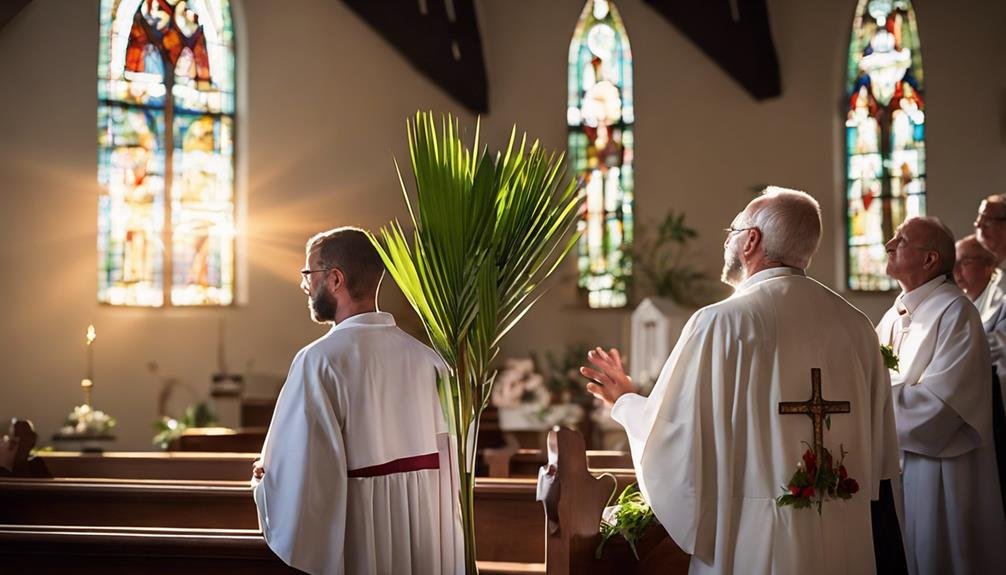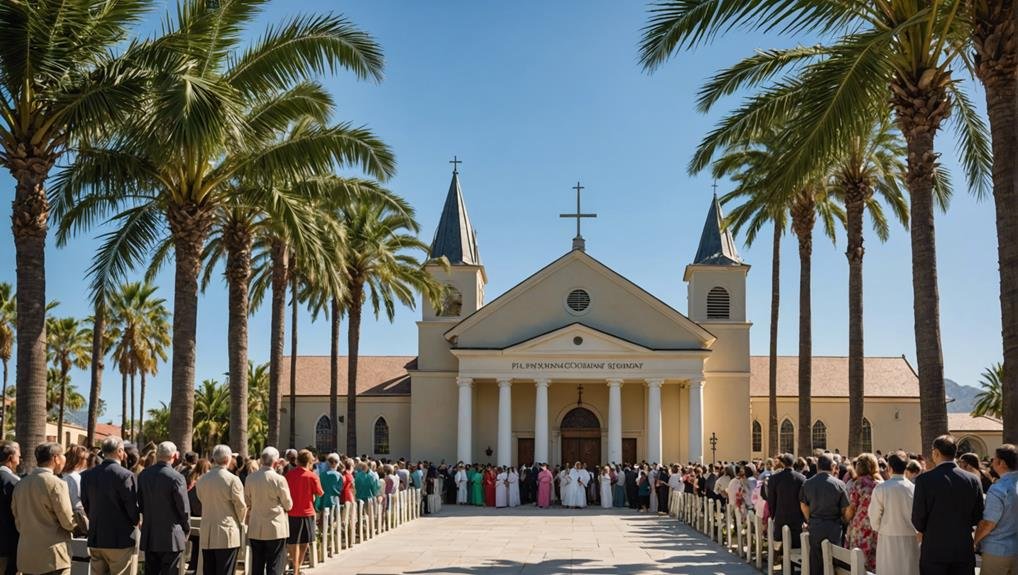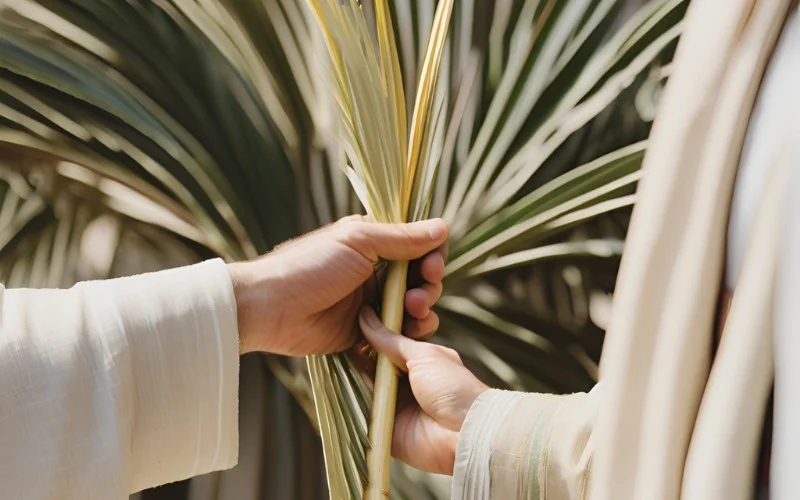You might wonder why Christians worldwide mark Palm Sunday with such reverence each year. It’s not just about commemorating Jesus Christ‘s historic entry into Jerusalem; it’s deeply rooted in the fulfillment of ancient prophecies and the stark symbolisms that resonate with believers today.
The ritual of waving palm branches, once a sign of victory, has evolved to signify peace and salvation, reflecting a profound narrative of triumph and humility.
Considering the varied rituals and their meanings, you’ll find that the layers of tradition and faith intertwined in Palm Sunday reflect a rich cultural tapestry and a personal journey of spiritual renewal. What might these symbols reveal about broader human experiences of hope and redemption?
Key Takeaways
- Palm Sunday marks Jesus’ triumphant entry into Jerusalem, symbolizing his recognition as the Messiah.
- It initiates Holy Week, culminating in Easter, reflecting on Jesus’ passion and resurrection.
- The event fulfills biblical prophecies, affirming Jesus as the promised Savior who embodies humility and peace.
- Commemorating Palm Sunday encourages reflection on Jesus’ humility, service, and the virtues he taught.
- The celebration involves global Christian communities, enhancing unity and shared faith through diverse cultural observances.
Biblical Account of Palm Sunday
Palm Sunday marks the day Jesus triumphantly rode into Jerusalem on a donkey, an event all four Gospels recount. As you immerse yourself in the narratives of Matthew, Mark, Luke, and John, you’ll find they each portray this moment with vivid details that highlight its significance.
This event isn’t just a simple entry; it’s a fulfillment of prophecy from Zechariah, pointing to Jesus as a humble yet sovereign king. You’ll notice that as Jesus entered Jerusalem, the crowd’s actions were charged with meaning.
They didn’t just stand by; they actively participated by waving palm branches and laying their cloaks on the road. This wasn’t a typical welcome.
It was a gesture of honor and recognition of Jesus’ kingship, a poignant moment in Christian tradition illustrating the people’s acknowledgment of Jesus as the Messiah. Each year, Christians worldwide commemorate Palm Sunday to remember this pivotal moment.
It’s a celebration that connects believers to the path Jesus walked, from his triumphal entry through the events of Holy Week. This day isn’t just a historical event; it’s a live echo of faith, a collective remembrance that stirs the hearts of millions.
Symbolic Use of Palm Branches
Reflecting further on Palm Sunday, consider how the palm branches used by the crowd honored Jesus and symbolized victory and peace. As you explore deeper into this event, you’ll find that these branches weren’t just random foliage but held deep significance.
In biblical times, people waved palm branches to celebrate triumphs and express their longing for peace. Therefore, when the crowd welcomed Jesus with palms, they weren’t only greeting him and heralding him as a victorious leader and a harbinger of peace.
The tradition of using palm branches has endured because it encapsulates the essence of Jesus’ entry into Jerusalem. This act wasn’t just a momentary celebration; it was a profound declaration of Jesus’ role as Savior and King.
Each year, as you hold those palm branches during Palm Sunday services, you’re connected to that historical moment, recalling Jesus’ teachings and his triumphant approach toward his destiny.
These branches thus serve as a powerful reminder of victory over sin and the peace that Jesus promises to all believers. They’re more than symbols; they’re an invitation to reflect on your faith and the profound spiritual journey that Palm Sunday represents.
Prophecies Fulfilled by the Event

On Palm Sunday, Christians witness the fulfillment of ancient prophecies, such as those declared in Zechariah 9:9, through Jesus’ humble entry into Jerusalem on a donkey.
This significant event isn’t just a ritual but a profound prophecy fulfillment that underscores Jesus’ identity as the Messiah.
The prophecy in Zechariah 9:9 emphasized peace and humility, predicting that the true King would come, ‘righteous and victorious, lowly and riding on a donkey, on a colt, the foal of a donkey.’ This vivid imagery was brought to life when Jesus entered Jerusalem, aligning perfectly with the prophetic words.
The fulfillment of these prophecies is central to Christian belief, affirming Jesus as the promised Savior who came not in grandeur but in humility. This day is a stark reminder of the peace and humility that Jesus embodied, prophesied centuries before his birth.
Each year, as you commemorate Palm Sunday, you’re not just remembering an ancient event. Still, you’re also acknowledging the deep roots of faith in prophecies that heralded the arrival of a Savior who’d change the course of history.
Cultural Impact Across Nations
Christians across various countries celebrate Palm Sunday with distinct traditions that reflect their unique cultural heritage. This day marks the beginning of Holy Week and is deeply embedded in Christian traditions, yet it’s fascinating to see how different cultures have adapted these practices.
Palm branches, a symbol of peace and victory, unite these celebrations, but each region adds its cultural twist to this observance. Here are three ways in which Palm Sunday showcases the cultural impact across nations:
- Regional Names: Palm Sunday is known as Flowering Sunday in some parts of the world. This name variation highlights the observance’s diverse cultural adaptations, integrating local flora into the celebrations.
- Cultural Practices: From the grand processions in Italy to the humble gatherings in smaller villages of Ethiopia, each practice reflects the local customs and societal values, demonstrating the evolution of traditions within the global Christian community.
- Symbolic Items: While palm branches are common, regions with less access to palms use branches from locally available trees, showing adaptability and respect for local environmental conditions.
These variations enrich the global Christian community and promote a deeper understanding and appreciation of diverse cultural practices.
Rituals and Traditions Observed
Building on these cultural variations, let’s explore the rituals and traditions Christians observe during Palm Sunday. You’ll find that these practices are deeply entrenched in the remembrance of Jesus’ triumphal entry into Jerusalem.
One of the most significant traditions is the procession with palm branches. These aren’t just any branches; they symbolize victory and peace, echoing the sentiments of those who welcomed Jesus into Jerusalem centuries ago.
Walking with these palms, you’re stepping into a profound historical and spiritual significance moment. Here’s a quick look at some key practices:
| Tradition | Description |
|---|---|
| Palm Branches | Carried in processions to symbolize victory. |
| Blessing of Palms | Clergy bless palms before they are distributed. |
| Gospel Reading | Gospel accounts of the entry are read in services. |
| Focus on Humility | Emphasizes service and humility in commemorations. |
Moreover, the clergy play an important role by blessing these palm branches before they’re handed out to you and others in the congregation. This act isn’t just ceremonial; it’s a call to reflect on humility and service, core tenets highlighted on Palm Sunday through the Gospel accounts.
Theological Significance Explained
Understanding the theological significance of Palm Sunday helps us grasp why this day is so pivotal in the Christian faith. When you celebrate Palm Sunday, you’re not just remembering a historical event; you’re engaging in a profound act that connects deeply with the roots of Christian doctrine.
Here’s why this Sunday is so essential:
- Fulfillment of Prophecy: On Palm Sunday, Jesus entered Jerusalem, fulfilling ancient prophecies about the Messiah. This public act declared His royal and messianic identity central to Christian belief.
- Beginning of Holy Week: This day initiates the Holy Week, a sacred period that leads to Easter Sunday. It sets the stage for the Passion — the suffering, death, and resurrection of Jesus — encapsulating the core of Christian salvation history.
- Spiritual Invitation: The celebration serves as a spiritual reminder to open your hearts and lives to Jesus, similar to how the crowds welcomed Him with palm branches. It’s a call to reflect on His humility and the teachings that challenged and changed the world.
Role in Holy Week Celebrations

During Holy Week, Palm Sunday plays a critical role as it initiates a series of events leading up to Easter Sunday, focusing on reflection and preparation for Jesus’ resurrection.
This pivotal day in the Christian calendar marks the start of a deeply spiritual journey that commemorates the final days of Jesus’ life on earth. Palm Sunday isn’t just any ordinary day; it’s a profound observance that sets the tone for the following holy days.
You celebrate Palm Sunday annually to remember Jesus’ triumphal entry into Jerusalem, which fulfilled ancient prophecies and signaled the beginning of his Passion.
Today, you might participate in processions, waving palm branches to symbolize the palms laid before Jesus as he entered the city. These processions aren’t just ritualistic; they’re a physical manifestation of your spiritual preparation for Easter.
Moreover, the readings of the Passion, which detail the events leading up to Jesus’ crucifixion, are integral to Palm Sunday services. They serve as a sad reminder of Jesus’ sacrifices and the profound spiritual lessons he imparted. Through these observances, you’re invited to reflect deeply on the themes of sacrifice, redemption, and renewal inherent in the Easter story.
Variations in Global Observances
While Palm Sunday traditions share core themes, how you observe them can vary widely worldwide. This Christian tradition marks the start of Holy Week and commemorates Jesus’ triumphant entry into Jerusalem.
Across the globe, the blessing of palms and processions take special forms, reflecting local customs and historical influences. Here’s a glimpse of the unique global observances of Palm Sunday:
- Belgium: Known as ‘Branle de Tournai,’ you’ll find yourself amidst traditional dances and music that add a festive flair to the religious observance.
- Egypt: Palm Sunday transforms into ‘Sham El Nessim,’ a day when you can join in on outdoor picnics and enjoy festive gatherings, blending ancient Pharaonic traditions with Christian practices.
- Italy: Experience Palm Sunday with intricately woven palm fronds and olive branches. The processions here are particularly elaborate and serve as a beautiful expression of faith and craftsmanship.
Each country adds its color to the celebration of Palm Sunday, making it a richly diverse and deeply significant event in the Christian calendar. Whether it’s through dance, outdoor activities, or artistic expression, the essence of this day is celebrated with great reverence and joy around the world.
Contemporary Relevance and Practices

In today’s world, Palm Sunday’s practices honor Jesus’ historical entry into Jerusalem and resonate deeply with modern Christians, reminding them of the virtues of humility and sacrifice.
Across various Christian denominations, the significance of this day is universally acknowledged, though the observances may differ. The blessing of palm branches, symbolic of peace and victory, is a physical reminder of Jesus’ sacrifice. This is a time when you’re encouraged to reflect deeply on the values he embodied.
As you participate in Palm Sunday services, you engage in practices steeped in tradition yet incredibly relevant in today’s context. The processions replicate Jesus’ humble entry on a donkey, endorsing humility over grandeur.
This act of humility is a powerful lesson in service and sacrifice, virtues that are ever more important in a world often driven by personal gain. During these observances, reflection becomes a key element.
It’s a moment to ponder your life in the light of Jesus’ teachings. How do you embody humility? Are you living a life of service to others? Palm Sunday isn’t just a historical memory; it’s a call to carry forward these timeless values in your everyday actions.
Educational Resources and Further Reading
For those interested in exploring the significance and traditions of Palm Sunday further, a variety of educational resources and reading materials are available. These resources dig deep into the triumphal entry, its symbolism, and how it’s observed across different Christian communities.
Here’s a list to get you started:
- Books: Look for titles like ‘The Final Week of Jesus‘ by Max Lucado. This book explores the events of Holy Week, including Palm Sunday, and provides insights into Jesus’s actions and teachings during this pivotal time.
- Documentaries: Search for documentaries such as ‘The Week That Changed the World,’ which offers visual and scholarly perspectives on Palm Sunday and its role in the Christian faith, highlighting both Catholic and Protestant viewpoints.
- Online Courses: Platforms like Coursera or Udemy often feature courses on Christian theology that include lectures on Palm Sunday. These can help you understand the broader context of the event within Christian liturgy and its impact on modern Christian practices.
These resources will deepen your understanding of why Palm Sunday holds such profound significance in Christian liturgy and how its celebration varies across different denominations.
Conclusion
As you reflect on Palm Sunday, remember that it’s not just about historical events but also about their deep spiritual significance. Participating in these traditions means stepping into a story of prophecy, humility, and ultimate love.
Whether waving palm branches or reading about Jesus’ entry into Jerusalem, you’re part of a global community celebrating this pivotal moment in Christianity. So, continue exploring and embodying these teachings daily to keep the spirit of Palm Sunday alive.
Check Out More Articles:
Why Is Palm Sunday Celebrated in Christianity?
Who Are Israelites: Unveiling the Ancient People of the Bible
What Is the Last Book of the Old Testament? Discover the Final Chapter


